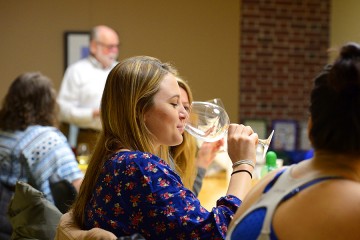In a small seminar room in the Undergraduate Teaching Laboratories on Johns Hopkins University's Homewood campus, nine students debate a common dilemma in scientific publishing: how to determine who should get credit as a study's lead author.
"I feel like it would've been fair to make Kimberly the lead author and Michael the corresponding author," one student says, referencing the character's names on the case study worksheet. "She did a lot of the work, like having to craft a narrative out of the scientific method. She basically redid the entire thing."
"But it was Michael's idea, and that's a big deal. I think it's fair to make them both co-lead authors."
"But Michael is listed first. If another journal cites the study, only Michael's name gets mentioned."
Emily Fisher, a professor in the Krieger School of Arts and Sciences' Department of Biology, interjects: "So do you guys think this problem happens a lot?"
"Yes," the class agrees unanimously.
Reading and Tweeting Science, a one-credit Intersession course, delves into what happens after scientists finish their studies and are ready to publish their work. Like academia, the scientific world tends to operate under the principle of "publish or perish," and it can be cutthroat, filled with demanding journal editors and peer reviewers who may be conducting competitive or contradictory studies of their own.
And in the digital age, there's the added gauntlet of Twitter to navigate, of course.
Fisher prepares her students for that world with case studies, but she adds in personal and secondhand publishing anecdotes—because every scientist has them.
There's the example of a study collaborator who developed an essential research protocol but resigned before the study could be completed. He was ousted from the list of collaborating authors despite his contributions for the dubious reason that he was attending dental school, and therefore didn't need the publishing credit. There's the story of blatant sexism, where preference was given to a male scientist over a female scientist because as a man, he "needed more money."
And then there's the story of Jonathan Eisen, a genomics scientist who edited a journal article on the human microbiome, only to have scientists on Twitter critique—and nearly eviscerate—the research methodology, the conclusions drawn by the study, and the media coverage surrounding its release.
@WvSchaik @MicrobialMe @BetaScience @PatSchloss oh god what have I contributed to here?
— Jonathan Eisen (@phylogenomics) October 18, 2016
just want to note @JulesDeep @PatSchloss @PatSchloss @merenbey et al. thanks for public comments; post pub review is critical in science
— Jonathan Eisen (@phylogenomics) October 19, 2016
These examples are among the deep dives Fisher takes to explore the scientific publishing industry, the resources available, and the common pitfalls the young scientists in the class should avoid. She says it's important to understand how a study's byline hierarchy works—the first and last authors listed receive the most credit—because scientists might inadvertently forfeit credit for their work.
Online forums can provide a place for pre-publication feedback, so scientists can avoid public tweet-critiques like Eisen's. And some sites publish so-called "negative results," the not-so-flashy studies that confirm accepted hypotheses or further disprove previously debunked theories. These studies might not be worth taking up print space in a journal for, but they are still necessary science, and knowing where to find them online can prevent accidental (and costly) replications, Fisher explains.
Aspects of the class also focus on the soft skills—crafting an accessible and readable abstract, the importance of participating in the online community of scientists, and how to tailor scientific writing to specific audiences. After all, says Fisher, scientists don't just write for their peers anymore. The Internet has democratized information, and increasingly the science community and its institutions are adapting.
For Tony Yang, a first-year student who plans to explore public health fields like epidemiology, popular social media platforms have a practical health application by creating direct lines of communication between scientists and the public. In class, he points out that government agencies like the CDC used Twitter in the midst of the Zika epidemic to share critical health advisories.
"A lot of the reason I took this class has to do with outreach and communication with different populations," he says. "You have to be able to share your research effectively with the public."
Posted in Science+Technology, Student Life
Tagged undergraduate research, twitter, intersession










